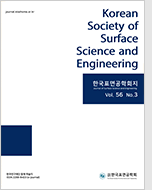
- Past Issues
- e-Submission
-

2021 Impact Factor 1.766
5-Year Impact Factor 1.674
Editorial Office
- +82-2-563-0935
- +82-2-558-2230
- submission@kssse.or.kr
- https://www.kssse.or.kr/

2021 Impact Factor 1.766
5-Year Impact Factor 1.674
The Korean Society of Surface Science and Engineering 2024;57(2):92-97. Published online: May, 16, 2024
DOI : 10.5695/JSSE.2024.57.2.92
The LiBr aqueous solution, which is the absorption liquid of absorption refrigerator, must be replaced periodically because the concentration of impurities such as Cu2+, Fe2+, Ca2+, etc., increases due to corrosion of the tubes as the period of use increases, and the refrigeration efficiency decreases significantly. In order to reuse the waste absorption liquid, flocculation-precipitation method is mainly applied to precipitate the impurities, which requires hundreds of times the concentration of impurities and generates additional waste. In this study, a process for removing Cu ion impurities from cyclone electrolyzer by electrolytic reduction is presented in a small-scale facility without additional waste. It was confirmed that Cu ion impurities can be removed down to 1 ppm by electrolytic reduction process, and to further improve the removal rate, the mass transfer rate was increased by using a cyclone electrolyzer. The removal rate of Cu ions increased with the increase of flow rate and current density, and it was confirmed that Cu was removed at a rate of 1.48 ppm/h under the condition of 330 mL/sec and 2.5 mA/cm2.
Keywords Absorption refrigerator, Lithium bromide, Copper ion impurity, Electrowinning, Cyclone